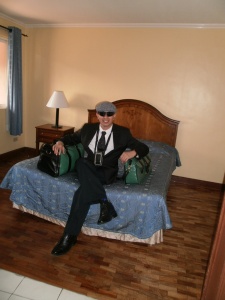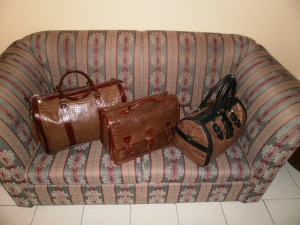People in the fashion industry have faced considerable stereotypical prejudices that could quell the creative fire in many aspiring designers and creators. One leading US “fashion” lawyer, Susan Scafidi, said that these prejudices reflect on the lawyers who strive to espouse the rights and protect the interests of people and entities in the fashion industry. Many law schools and academics had scoffed at the idea of “fashion law” and deem it embarrassing, or not worth the trouble, except probably for women, gays and people of color. As a long time legal advocate of people in the creative and fashion industries, visual artist and designer himself, Dr. Atty. Noel G. Ramiscal

Dr. Atty. Noel G. Ramiscal modelling his two designed green and black leather portfolio and travelling bag
knows about these prejudices only too well. Much of these stem from the notions that fashion is “ephemeral”, “frivolous” or downright “unimportant”. Yet, the annual global income take of fashion industries have ranged (depending on what source one believes and the year) from a quarter of a billion to nearly a trillion US dollars.
Fashion has always been a barometer of peoples’ consciousness and subconsciousness. Witness the trends for apparel and leatherwear influenced by the biker culture, Hell’s Angels and the sadomasochism glorified by Marquis de Sade. Don’t forget the military inspired trench coats, pants, booties and other accessories that come from the deeply seated concerns for control and domination in a world afflicted with terrorism. Consider the fact that human hair was used by Christian Louboutin as a feature of his stilettoes. Some may remember that hair was harvested from the holocaust victims to be made as material for pillows so that the Reich officialdom can sleep better.
Pillows, stilettoes, with the touch of macabre memories, fashion can humanize a demonized mnemonic culture. When the late Alexander Mcqueen’s work was presented as a retrospective after his death, the greatness of his haute couture can be ascertained from his sculptural and even architectural approach, as well as his genius in accessing infamous and hurtful historical events and turning them into sometimes, terrifying, but always exhilarating collections. His “Savage Beauty” retrospective at the Met Costume Institute installed in 2011 featured a tribute to the “Widows of Culloden”, a collection influenced by the massacre of the Scottish Jacobites by the English army in 1745. A gown represented in the retrospective was an architectural wonder of lace and tulle that evoked the vulnerability and nobility of character of the women victims.
In the Philippines, many creative designers and artists struggle to find recognition and acceptance in the national and international scene. While there is no shortage of talent, there is a dearth of academic and historical appreciation, as well as legal protection for the rights and interests of those in the fashion industries. This is due to several reasons. First, the legal framework for even starting the discussion of the proprietary rights of fashion designers over their creations is not clearly delineated or is unsuitable. The Philippine Intellectual Property Code suffers from a lack of understanding of the demands of creative industries like fashion, where the rules can change from season to season and even in mid-season. Second, there is no Philippine jurisprudence that addresses squarely the concerns of fashion designers. Third, many fashion designers, particularly those starting out have no desire to be involved in any legal tussle that could derail their careers. They work for a pittance and endure work conditions that might be considered harsh and they are expected to take these easily in stride, because most of them are “gay” anyway. Abuse is justified by the macho and cavalier attitude that is still prevalent in Philippine society where being “gay” is considered a “weakness”. Fourth, there is no current academic degree or offering in the Philippine setting targeted to fashion students, and the disciples of “style” that actually introduces, links and reinforces the legal rights of fashion designers in the stages of their intellectual creations, from the drawing of the design to the franchising of their brand, in a practical manner. Fifth, there is a lack of a united advocacy for the rights of designers, stemming from the four previously cited factors.
Another important factor that should be considered in the Philippines is the ubiquitousness of technology. While computer aided designs (CADs) are quite useful in the realization of designs for apparel, and the scalability of patterns for these designs, the same technological devices and software make it easy to reproduce copies of the designs and mass-manufacture them, without the consent or control of the original designer. Added to that are big malls in the Philippines, as well as retail stores or “stockists” in Divisoria that sell knock-offs of original creations for a fraction of the price of the original designs. A cautionary tale is that of the American designer, Narciso Rodriguez, who designed the wedding gown of the late Carolyne Bessette Kennedy. His gown became the most copied “silhouette” of the nineties with its special seam construction. Retail companies reportedly sold seven to eight million copies of the gown, a single copyist sold eighty thousand copies, while Mr. Rodriguez was only able to sell less than fifty pieces of his original design.
As the push for recognition of the rightful place of fashion in the Philippine economy and consciousness snowballs, as borne by television shows like Project Runway Philippines, Dr. Atty. Ramiscal
trusts that those who work in the fashion industry, in whatever aspect, would work together with him for the protection of the rights of designers and small to medium sized businesses engaged in fashion. In a world of changing hemlines, palettes and faces, there are still constants like respect and recognition of one’s work and rights. There is no other industry in the Philippines that has been ignored for the longest time, which truly deserve this kind of attention now, as the Philippine fashion industry.





